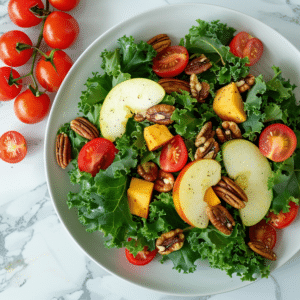
With butternut squash and baby kale, this dressing is the perfect way to dress up any meal.
This salad offers a tantalizing combination of flavors and textures, with each ingredient thoughtfully selected to create a symphony of taste sensations. From the tender cubes of roasted butternut squash to the crisp slices of apple, every bite is a burst of freshness and nourishment. Tossed in a luscious dressing infused with maple syrup, apple cider vinegar, and garlic, this salad is a celebration of autumn flavors that will elevate any mealtime experience.

Butternut Brilliance: Sweet, Nutty, and Nutrient-Rich Delight for Diabetes Wellness!
Butternut squash, with its vibrant orange hue and naturally sweet flavor, offers a wealth of nutritional benefits for overall health, including support for individuals managing diabetes. Rich in vitamins, minerals, and antioxidants, butternut squash is a nutritional powerhouse that promotes well-being. It is an excellent source of vitamin A, providing a hefty dose of beta-carotene, essential for eye health, immune function, and skin health.
Additionally, butternut squash is abundant in vitamin C, an antioxidant crucial for bolstering the immune system and aiding in collagen production. Moreover, it boasts significant amounts of potassium, vital for regulating blood pressure and supporting proper muscle and nerve function.
With a low glycemic index (GI) and glycemic load (GL), butternut squash has minimal impact on blood glucose levels when consumed, making it a suitable choice for individuals mindful of their glucose levels. Its high fiber content further contributes to feelings of fullness and aids in digestion, supporting stable blood glucose control.
As for its taste, butternut squash has a distinct sweet and nutty flavor that sets it apart from other squash varieties. While it doesn't mimic the taste of real peanut butter, its natural sweetness and creamy texture make it a versatile ingredient that enhances a variety of dishes. From soups and salads to casseroles and desserts, butternut squash adds depth and richness to numerous recipes, making it a flavorful addition to any meal.

Kale Kickstart: Tiny Leaves, Big Diabetic Benefits
Baby kale, with its tender leaves and mild flavor, is a nutrient-packed green that offers a myriad of health benefits, especially for individuals managing diabetes. Rich in vitamins, minerals, and antioxidants, baby kale is a nutritional powerhouse that supports overall well-being. It is an excellent source of vitamin K, crucial for blood clotting and bone health, as well as vitamin A, providing beta-carotene essential for eye health and immune function.
Baby kale also contains vitamin C, an antioxidant that boosts the immune system and aids in collagen production. With a low glycemic index (GI) and glycemic load (GL), baby kale has minimal impact on blood glucose levels when consumed, making it an ideal choice for individuals monitoring their glucose levels. Its high fiber content further contributes to feelings of fullness and aids in digestion, supporting stable blood glucose control.
Despite its small size, baby kale packs a powerful nutritional punch and can be incorporated into a variety of dishes. Whether enjoyed raw in salads, blended into smoothies, or sautéed as a side dish, baby kale adds a vibrant burst of color and a nutritious boost to any meal. Its mild flavor makes it versatile and adaptable to a wide range of culinary creations, allowing individuals to reap its health benefits in delicious and satisfying ways.

Apple Appeal: Sweet, Crunchy, and Diabetic-Friendly Delight!
Apples, with their crisp texture and natural sweetness, are not only a beloved fruit but also offer a multitude of health benefits, making them a smart choice for individuals managing diabetes.
Packed with essential vitamins, minerals, and antioxidants, apples are a nutrient rich food that supports overall well-being. They are an excellent source of dietary fiber, particularly soluble fiber, which helps regulate blood glucose levels and promotes digestive health. Additionally, apples contain vitamin C, an antioxidant that boosts the immune system and aids in collagen production.
With a moderate glycemic index (GI) and glycemic load (GL), apples have a relatively mild impact on blood glucose levels when consumed, making them a suitable choice for individuals monitoring their glucose levels. Their natural sweetness satisfies cravings for something sweet without causing significant spikes in blood sugar.
Apples are incredibly versatile and can be enjoyed in a variety of ways. Whether eaten fresh as a convenient snack, sliced into salads for added crunch, or baked into desserts for a comforting treat, apples add a delicious and nutritious element to any meal. Their vibrant colors and juicy texture make them a delightful addition to both sweet and savory dishes, providing a burst of flavor and nutrients with every bite.


Apple Butternut Squash Salad with Maple and Garlic Dressing
Ingredients
- 3 cups butternut squash cubed
- 8 cups baby kale chopped
- 2 large apples with skin cored and sliced
- 12 cherry tomatoes
- 1 tbsp pecans chopped and toasted
- 2 Medjool dates pitted and chopped
- 2 tbsp maple syrup
- 2 tbsp apple cider vinegar
- 1 tsp dried thyme
- 1 tsp Dijon mustard
- 1 clove garlic chopped
Instructions
- Preheat the oven to 400°F. Prepare a baking sheet with parchment paper or a silicone mat.
- Place the cubed butternut squash on the baking sheet and bake, turning once, for 30 minutes.
- In a high-speed blender, blend the dates, maple syrup, apple cider vinegar, thyme, Dijon mustard and garlic until smooth.
- In a small pan dry roast the pecans for 3 minutes.
- Divide the squash, kale, apple slices, cherry tomatoes, and pecans onto two plates. Drizzle the dressing onto each salad.
Notes
- No pecans, use chopped walnuts

